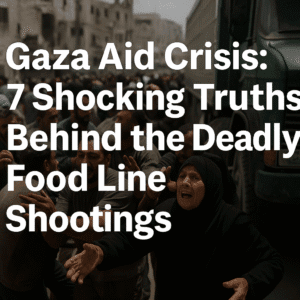Gaza Aid Crisis: 7 Shocking Truths Behind the Deadly Food Line Shootings
Israel’s military has launched a war crime probe following explosive allegations that soldiers deliberately fired on Palestinian civilians near Gaza aid sites, killing over 500 people in recent weeks. Soldiers anonymously confessed to Haaretz that commanders ordered lethal force against unarmed, starving crowds seeking food—a claim the IDF denies, calling incidents “isolated” while installing fences and new routes. This investigation collides with Gaza’s horrifying reality: families now face a life-threatening gamble to secure aid amid famine-like conditions, with thousands mobbing distribution points daily.
Legal experts challenge the IDF’s narrative, arguing systemic failures in crowd control protocols. Meanwhile, U.S.-backed aid groups deny deaths at their sites but demand transparent investigations, underscoring the chaos of coordinating survival under military occupation. The probe’s credibility hinges on examining command-level decisions—not just frontline soldiers—as Gaza’s civilian death toll surpasses 56,000. At its core, this is about whether international law can protect civilians when starvation becomes weaponized.

Gaza Aid Crisis: 7 Shocking Truths Behind the Deadly Food Line Shootings
The Israeli military’s investigation into alleged deliberate shootings of Palestinians near aid distribution points in Gaza is more than a legal procedure—it’s a litmus test for humanity in a conflict where survival has become a lethal gamble. As the death toll near food lines surpasses 500 (per Gaza authorities), this probe forces urgent questions about the rules of engagement in a famine-like crisis.
The Core Allegations: Intent vs. Chaos
- Soldier Testimonies: Unnamed IDF troops told Haaretz they were ordered to fire at crowds to “disperse” civilians—many unarmed and visibly malnourished—using disproportionate force.
- Military Denials: The IDF insists no shoot-to-kill orders existed, instead citing “isolated incidents” and new “safety measures” like fencing and additional routes.
- The Chasm: Legal officials reportedly rejected the IDF’s “isolated cases” argument in closed-door meetings, suggesting systemic issues in crowd control protocols.
Why Food Lines Became Killing Fields
- Desperation Mechanics: With 90% of Gazans facing acute food insecurity (UN data), crowds swarm aid trucks hours before arrival. Curfews on access routes force civilians into pre-dawn journeys, heightening chaos.
- The Vacuum of Governance: Hamas’s eroded authority and Israel’s security-first approach leave aid distribution dangerously uncoordinated. As one WHO official noted: “No one fully controls these zones—only fear does.”
- Soldier Psychology: Troops operating in high-threat environments often perceive crowds as potential threats. Training gaps in humanitarian law compliance may exacerbate trigger decisions.
Unanswered Questions
- Why did the U.S.-backed Gaza Humanitarian Foundation (GHF) deny any fatalities at its sites, contradicting Gaza health officials? Does this imply varying safety standards among aid groups?
- Can investigations meaningfully proceed without protected testimony from soldiers and victims? Past IDF probes (e.g., Shireen Abu Akleh’s killing) faced criticism for opacity.
- How does the reported 72 deaths in 24 hours (per Gaza’s June 28 update) reflect evolving tactics?
The Broader Reckoning
This probe emerges amid a catastrophic toll: 56,000+ Palestinian deaths since October 2023, widespread displacement, and UN warnings of “full-blown famine.” Yet these aid zone killings strike a unique chord—they lay bare the paradox of survival:
“Dying for bread” isn’t a metaphor in Gaza. It’s a daily calculus: risk bullets or watch your child starve.
International law is clear: intentionally targeting civilians violates the Geneva Conventions. Even if crowd control is the stated aim, indiscriminate fire violates the principle of proportionality. As a former ICC prosecutor notes: “Hunger cannot be weaponized, nor can desperation be criminalized.”
What Comes Next?
The investigation’s credibility hinges on:
- Transparent findings (unlike past “operational errors” rulings)
- Willingness to prosecute command-level decisions
- Input from Gazan witnesses, not just military sources
Until then, for thousands still queueing for sacks of flour under gunfire, justice remains as distant as food security.
You must be logged in to post a comment.